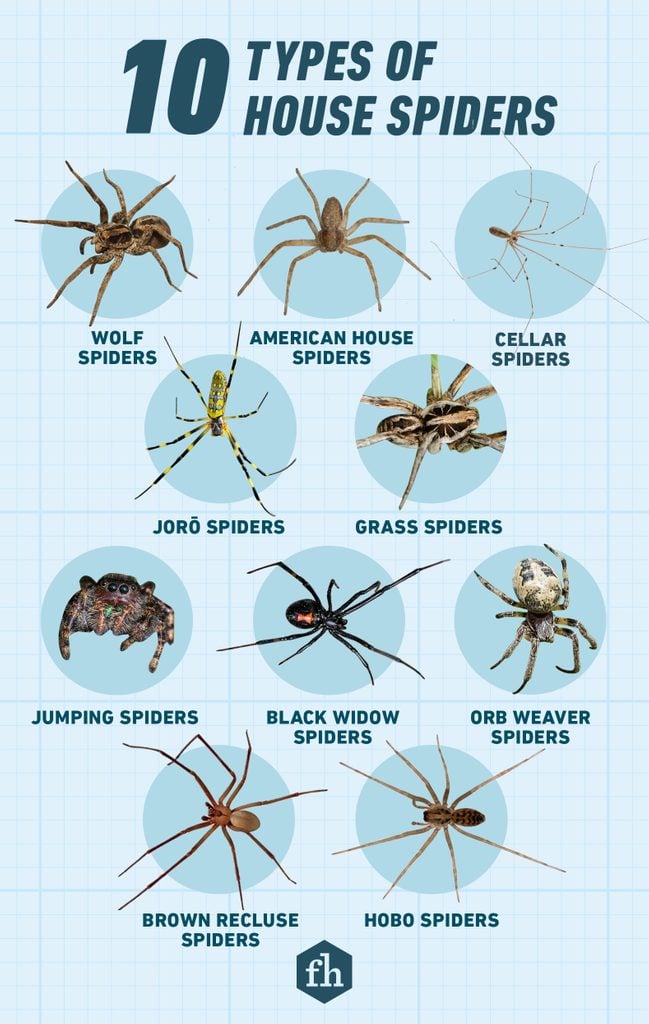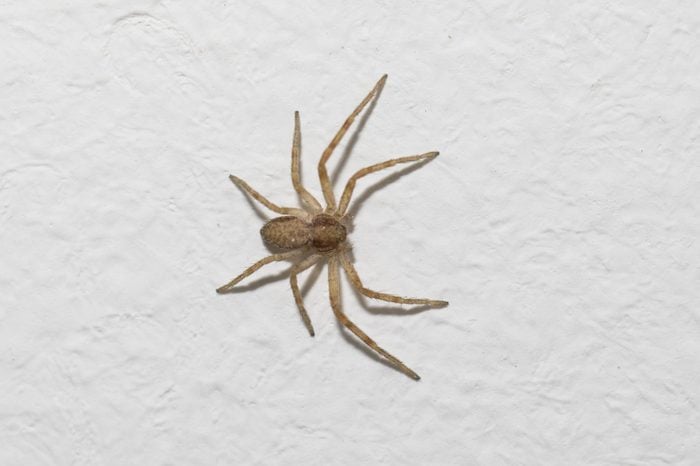
American House Spiders
Spinning their sticky webs in shadowy corners to capture mosquitoes, flies, wasps and cockroaches, the American house spider (aka common house spider) is more friend than foe.
What they look like: The word “common” is apropos when describing these unremarkable spiders. The colors of their globular bodies fall along the “drab” spectrum (from yellowish gray to brown to black), with streaks or mottled markings and darker-ringed legs. Females (the ones you see hanging in webs) are 3/16- to 5/16-in. long, and males generally a bit smaller.
Where to find them: There are about 230 species in this family throughout the U.S. and Canada. They cling to garage or barn doors, and hang between window panes or behind doors. Outdoors, they live in hollowed-out logs, shed eaves and solid, sheltered places.
What to do if you see one: Unless you suffer from arachnophobia or think you have an infestation, the common house spider is harmless, so just let them be.
How to prevent them: Seal cracks and other entry points around the outside of the house.
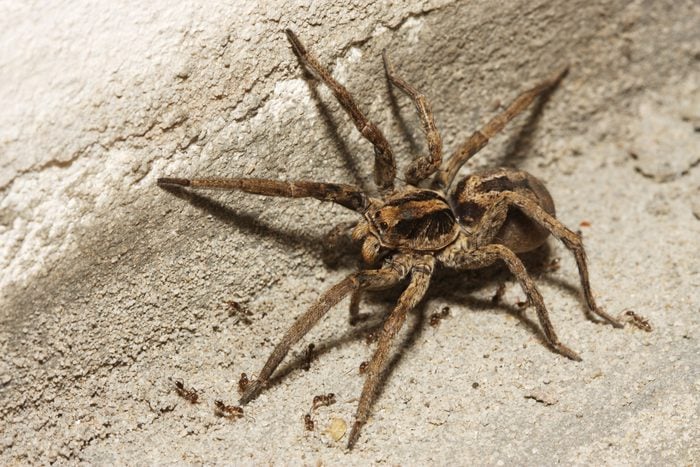
Wolf Spiders
The wolf spider is known for its athletic ability. It runs down prey instead of building idle webs. Wolf spiders have excellent eyesight with two rows of four eyes each, making them exceptionally adept at night hunting.
What they look like: Big, brown and hairy, the wolf spider resembles a smaller tarantula. Females are between 3/8- and 1-in. long and males vary from 1/4- to 3/4-in. Uniquely, females carry their egg sacs on their “bottoms.” After hatching, they carry their young on their backs.
Where to find them: In the U.S. and Canada, they live along streams, on sandbars, in gravel, or in low vegetation and leaf litter. Some burrow and tunnel while others may find their way inside your home. Generally speaking, wolf spiders prefer the outdoors.
What to do if you see one: Try not to scream! They may look intimidating, but they’re not poisonous and only bite if provoked.
How to prevent them: If shooing them outside doesn’t work, try placing glue traps around the house and then release them back into the wild.
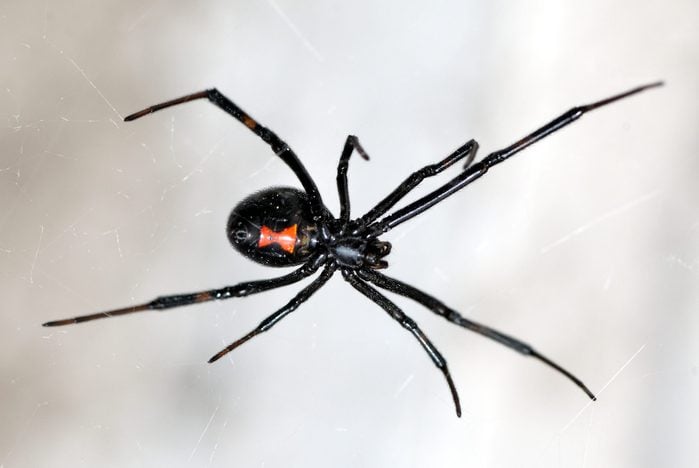
Black Widow Spiders
Notorious and rightfully feared, the black widow spider is the stuff of legend and myth. Said to eat her mate after their “romantic business” is complete, this rather violent dating ritual happens in nature less than we might think.
What they look like: The female black widow (3/8-in.) is identifiable by its pearly-black body and orange-to-red hourglass-shaped marking on the underside of the abdomen. The much slighter and harmless male is nearly half the size of a female, with faint red or white spots on the abdomen.
Where to find them: Though found worldwide, five species are most common in the Southern and Western United States. They spin sticky, irregular webs typically located near the ground. They prefer dry, warm places like wood piles, abandoned rodent burrows, under decks and in barrels, basements and crawl spaces.
What to do if you see one: Steer clear. Although not particularly aggressive, a female black widow’s neurotoxin venom is said to be 15 times stronger than a rattlesnake’s. Though rarely fatal, a bite can be extremely painful and cause muscle aches, nausea and breathing difficulties. Seek medical attention immediately.
How to prevent them: To control black widows and other bugs around your home, remove clutter and debris, keep the grass trimmed and install screens and door sweeps. To repel them, mix a DIY solution of essential oil (lemon, tea tree, eucalyptus, tea tree or peppermint), water and a drop of dish soap into a spray bottle and mist around the perimeter of your home.
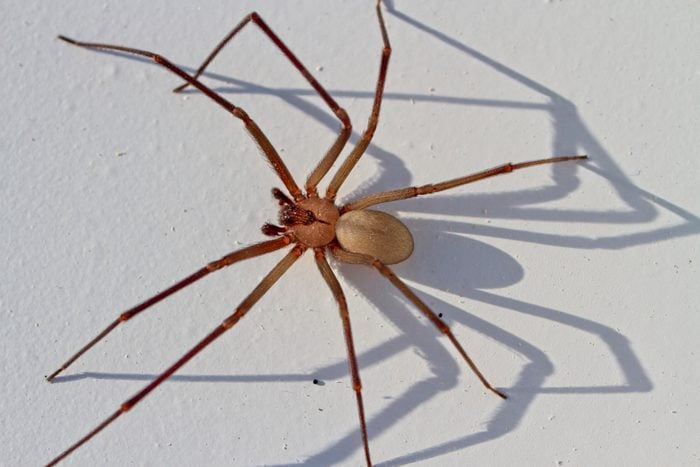
Brown Recluse Spiders
Another poisonous species, the brown recluse spider, as its name suggests, likes living the quiet life away from where the action is.
What they look like: This web-spinning arachnid presents with markings on the head shaped like a violin. Beside the distinctive markings and light-brown color, you can spot it by its six eyes; most spiders have eight. Their body size ranges between 1/4- to 1/2-in. long.
Where to find them: Native to the Midwest and Southern U.S., the recluse enjoys sheltering underneath dry logs, rocks and piles of leaves. They’re capable of wandering indoors to hide inside shoes in a dark closet or crash inside a little-used drawer.
What to do if you see one: Don’t mess with it. According to the Centers for Disease Control and Prevention (CDC), the brown recluse will bite humans if they’re unintentionally trapped against one’s skin. The venom causes severe lesions that may result in skin necrosis, requiring immediate medication intervention.
How to prevent them: Block access to you home as you would with American house spiders. Also, don’t leave clothing and shoes on the floor. Or, at the very least, shake them out before wearing.
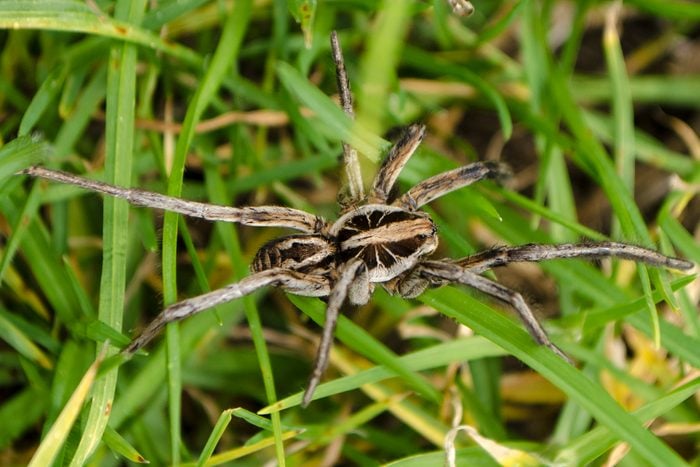
Grass Spiders
Among the most common spiders found in and around the home, the shy grass spider (aka a funnel-web spider) builds dense, silk-lined webs/burrows to trap its insect victims. They’re also super fast runners.
What they look like: Often confused with wolf or hobo spiders, grass spiders appear yellow, brown or cream-colored with two dark brown bands running across their bodies. They have long spinnerets (the silk-producing organ) and three rows of eyes arranged with two on top, four in the middle and two on the bottom. They average about 1/2-in. to 3/4-in. in size. Males are smaller.
Where to find them: Native to North America, they’re happiest in short grassy areas or on windowsills.
What to do if you see one: Nothing.
How to prevent them: To avoid a home infestation, mow the lawn and keep tree branches and shrubbery well-trimmed.
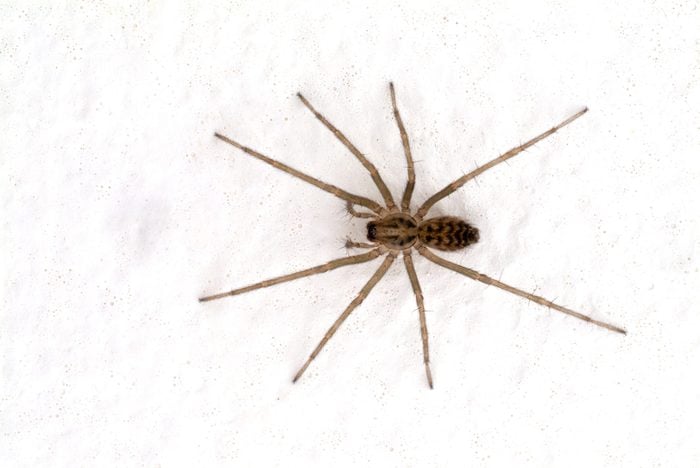
Hobo Spiders
Once unfairly categorized as dangerous, the hobo spider has been since removed from the CDC’s list of poisonous species.
What they look like: Known for an oblong abdomen with longer posterior spinnerets visible from above.
Where to find them: Common in the Northwest U.S., the hobo spider’s propensity for “hitching rides” helped it spread into other states. They like holes, cracks and nooks in moist, dark areas of the house. Since they don’t climb well, they stay pretty much at ground level.
What to do if you see one: Don’t disturb them. They will bite if provoked, causing mild pain and leaving a red mark. But that’s really the extent of their issues with humans.
How to prevent them: Eliminate hiding spots in garages and basements.
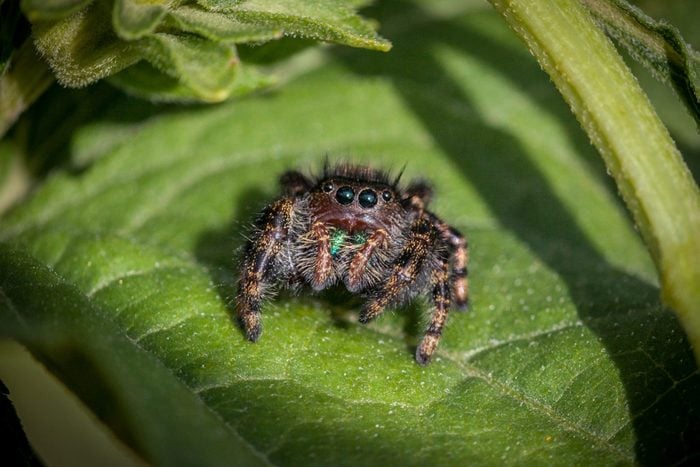
Jumping Spiders
These vaulting creatures have the best vision of any spider species and four strong pairs of legs for pouncing on their prey.
What they look like: They’re furry and cute. They come in brown, tan or gray with pale white, gray, yellow, red, blue or green markings. A variation called zebra spiders feature gray bodies with white markings on the front and tummies, with white or brown legs with gray rings.
Where to find them: Throughout the Eastern U.S.. Since this spider is always ready to spring into action, it prefers sunny, vertical surfaces like tree trunks, fence posts and walls.
What to do if you see one: Smile. They kind of look like they’re wearing goggles.
How to prevent them: No need. They prefer the outdoors so they’re unlikely to infest your home.
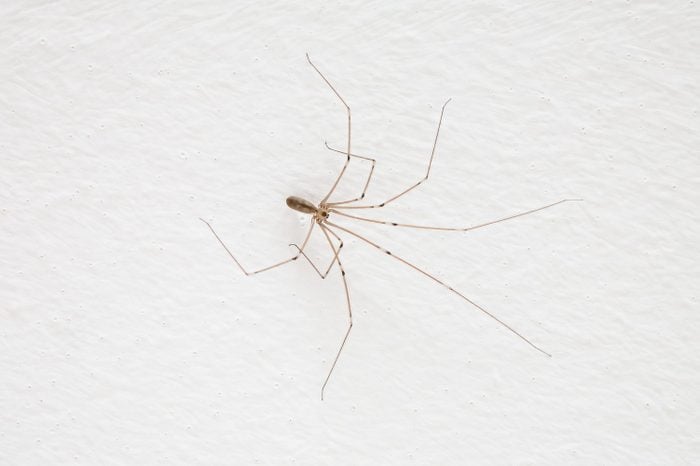
Cellar Spiders
Found in long- and short-bodied varieties, cellar spiders are sometimes mistaken for daddy-long legs, which are not actually spiders.
What they look like: Look for oval-shaped bodies ranging in color from pale yellow to soft brown or gray, and cylindrical abdomens three times longer than they are wide. Like most arachnids, cellar spiders have eight legs. But unlike other spiders, their limbs are unusually spindly and long.
Where to find them: Found all over the U.S., they like dark, dank, damp underground spaces like basements and cellars.
What to do if you see one: Since they build their webs on top of one another, they can become dense and may be considered an eyesore.
How to prevent them: Since they don’t bite humans (their fangs are too short to break the skin), it’s not necessary to do anything.
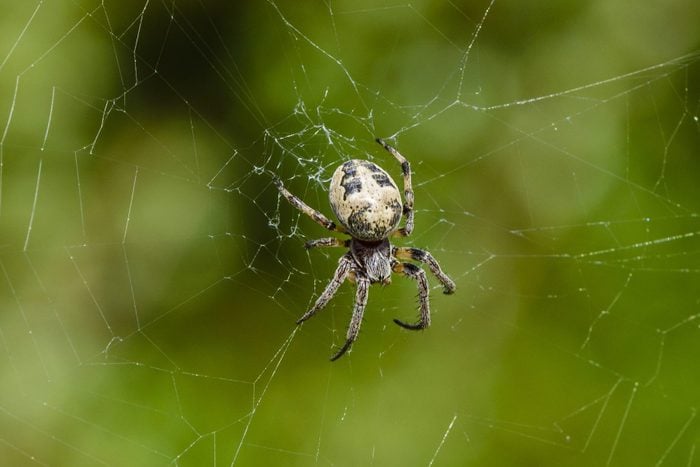
Orb Weaver Spiders
Looking like something out of a classic horror movie, the orb weaver spider’s web is a circular creation resembling the spoke of a wheel. You typically see them slung between garden plants and in forests.
What they look like: The spider itself can be bright reddish-brown to gray and measures from 1-1/2- to 3-in. long. Their body shape can vary, but typically it’s chubby and round. It’s possible to come across an orb weaver with white or brown dorsal stripes, too.
Where to find them: This family of spiders has more than 2,800 species spanning the globe, with some 180 species inhabiting North America.
What to do if you see one: Nothing.
How to prevent them: If a particularly large web is a nuisance, sweep it away with a broom. But in the yard, why bother? They’re works of art.
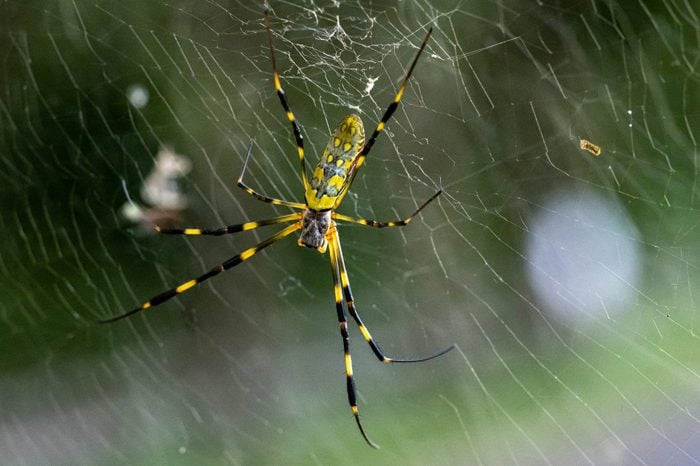
Jorō Spiders
The jorō spider‘s humongous size, as well as its ability to balloon through the air and build cobwebs the width of a Mack truck, have made this spider an internet sensation.
What they look like: Easily recognizable by its enormous girth (up to three inches across), the jorō spider has a beautiful yellow body with bluish-green and red strips. Its silk is gold.
Where to find them: Endemic to Southeast Asia (most commonly in China, Japan, Korea, Taiwan, Vietnam and India), the jorō spider arrived in the Southeastern U.S. a little more than a decade ago.
What to do if you see one: Try not to accidentally walk into its giant golden-yellow web.
How to prevent them: Experts believe there’s no reason to get rid of them. They pose no threat to humans, and are great predators of unwanted garden pests like stink bugs and mosquitoes.

